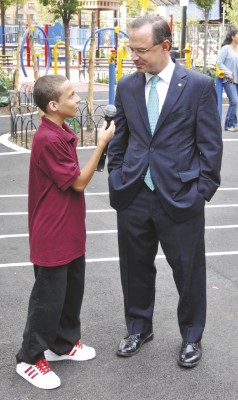Lessons from a Park Ranger

When Hurricane Sandy pounded the US east coast last October, its victims were not only the destroyed buildings and the residents who were left homeless in its wake. Many of New York City’s beautiful parks suffered widespread damage too.
For Adrian Benepe, the former New York City Parks Commissioner and a chief architect of the city’s renaissance in parks, the devastation was a particularly painful lesson.
“We must learn from this incident, and begin the difficult work of adapting this 400-year-old port city to the new global climate realities. If we don’t, this city and others like it may not last long into the third millennium,” he told Challenge.

Building more resilient cities to weather natural disasters can mean creating green infrastructure, such as rain gardens that capture storm water to prevent floods; as well as preserving salt marshes that act as coastal buffers against storms – projects that could help New York City in the future, he added.
Last July, Mr Benepe was in Singapore to receive the Lee Kuan Yew World City Prize, which honours vibrant and sustainable cities. It was awarded as part of the biennial World Cities Summit.
But for Mr Benepe, his earliest experience of the city’s parks was a “dispiriting” one. He was 16 then, and held a summer job at the Parks Department, cleaning public pools and picking up rubbish at ball parks.
In those days, New York’s parks were run-down. Even the famous Central Park was a “disaster”, he said, monuments were covered in graffiti and there were no rules, regulations or park rangers.

Still, the teenager had found his calling. Eager to make a difference, he applied to join the first batch of park rangers right after university. Except for a brief stint in journalism, Mr Benepe would go on to spend a total of 27 years working with the parks. He was made the city’s Commissioner of Parks and Recreation in 2002: custodian of 29,000 acres (11,735 hectares) of parklands, about a sixth the size of Singapore island.
During his 10-year tenure under Mayor Michael Bloomberg’s administration, Mr Benepe oversaw the city’s biggest parks expansion since the 1930s. He added new parks and planted more than 500,000 trees. About 84% of New Yorkers now live within a 10-minute walk of a park. These achievements contributed to the city’s transformation that has been widely recognised.
But his proudest achievement, he told Challenge, was “the very dramatic improvement of the parks over 30 years, which I got to be part of”, particularly that of Central Park.

Central Park in autumn
Public-private partnerships
Much of this, he stressed repeatedly during the interview, is due to the many successful public-private partnerships that have blossomed in the city. As government budgets shrank, millions of dollars of private money were sought to maintain parks. More importantly, volunteers rolled up their sleeves to care and manage them, like their own.

“People really care about their parks because most New Yorkers don’t have a front yard or backyard. We feel that the parks belong to us.” he said.
The first public-private partnership, the Central Park Conservancy, was created in 1980 when the city was on the brink of bankruptcy and had scant resources for its parks. Since then, the Conservancy has raised a total of US$470 million, helping to transform Central Park from “disaster” to a leading tourist attraction. Today, the Conservancy manages all aspects of Central Park except for security.

This strong sense of ownership has been replicated at parks such as the High Line, a new public park built on a historic freight rail line elevated above the streets of Manhattan. Slated for demolition, it was saved by a non-profit group, “Friends of the High Line”, that worked with the city to preserve and reuse it as a park. They now manage the park and raise more than 90% of its annual operating budget.
“Thirty years ago… none of these groups existed, except for a handful. Now there are tens of thousands who are engaged in the life of every park,” Mr Benepe said.
An independent study of New York City’s parks in 2011 found that the most successful ones had a strong volunteer network. The income levels of residents around the parks or the fundraising prowess of conservancy groups mattered less than the commitment of volunteers who plant trees, weed gardens, do landscaping work, and pick up litter, among other activities.
Creative use of land
During his lecture at the Summit, Mr Benepe pointed out that many of the new parks his department was able to add were a result of innovative re-zoning of land by the Department of City Planning.

For instance, West Chelsea (where the High Line park is located) was originally zoned for manufacturing. The decline in the manufacturing sector led to a glut of underused land. City planners re-zoned West Chelsea to allow for residential development and the creation of the park. The new park then spurred the construction of more than 40 new buildings around it. The re-zoning led to a US$2 billion in private sector investment, more than 10 times the US$150 million the City had invested in the High Line park.
Today Mr Benepe, who left the Parks Department a few months after his Singapore visit, continues his lifelong association with the parks. He is now with the Trust for Public Land, a conservation organisation that creates parks and playgrounds in cities across the US. This is where he continues to promote the public-private partnership model that he so believes in.
This is the second of a three-part series on the World Cities Summit that was held in Singapore in July 2012. Read the first part, The Wheel To Succeed, and the third part, Making A Sustainable Comeback.
- POSTED ON
Jan 10, 2013
- TEXT BY
Bridgette See









